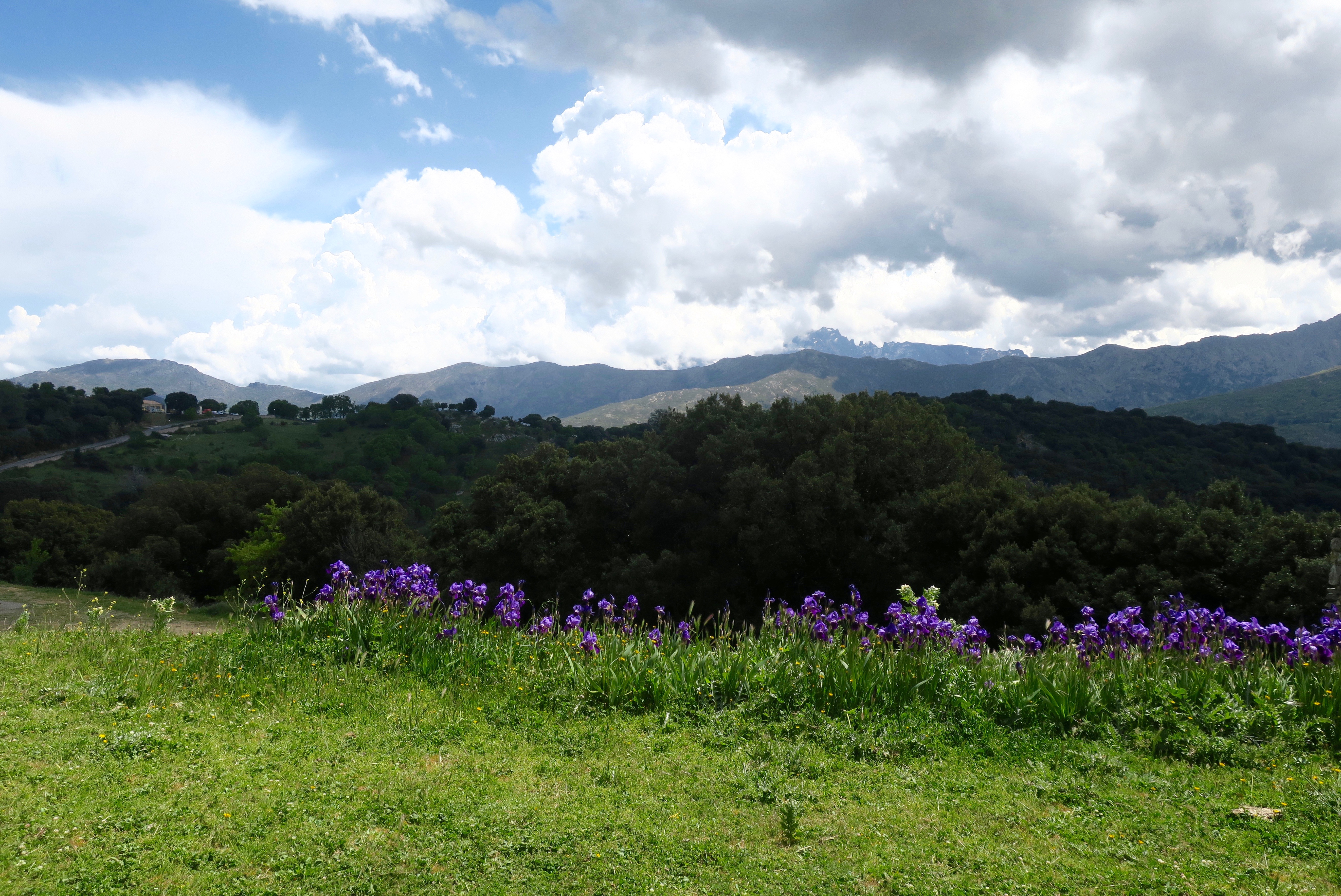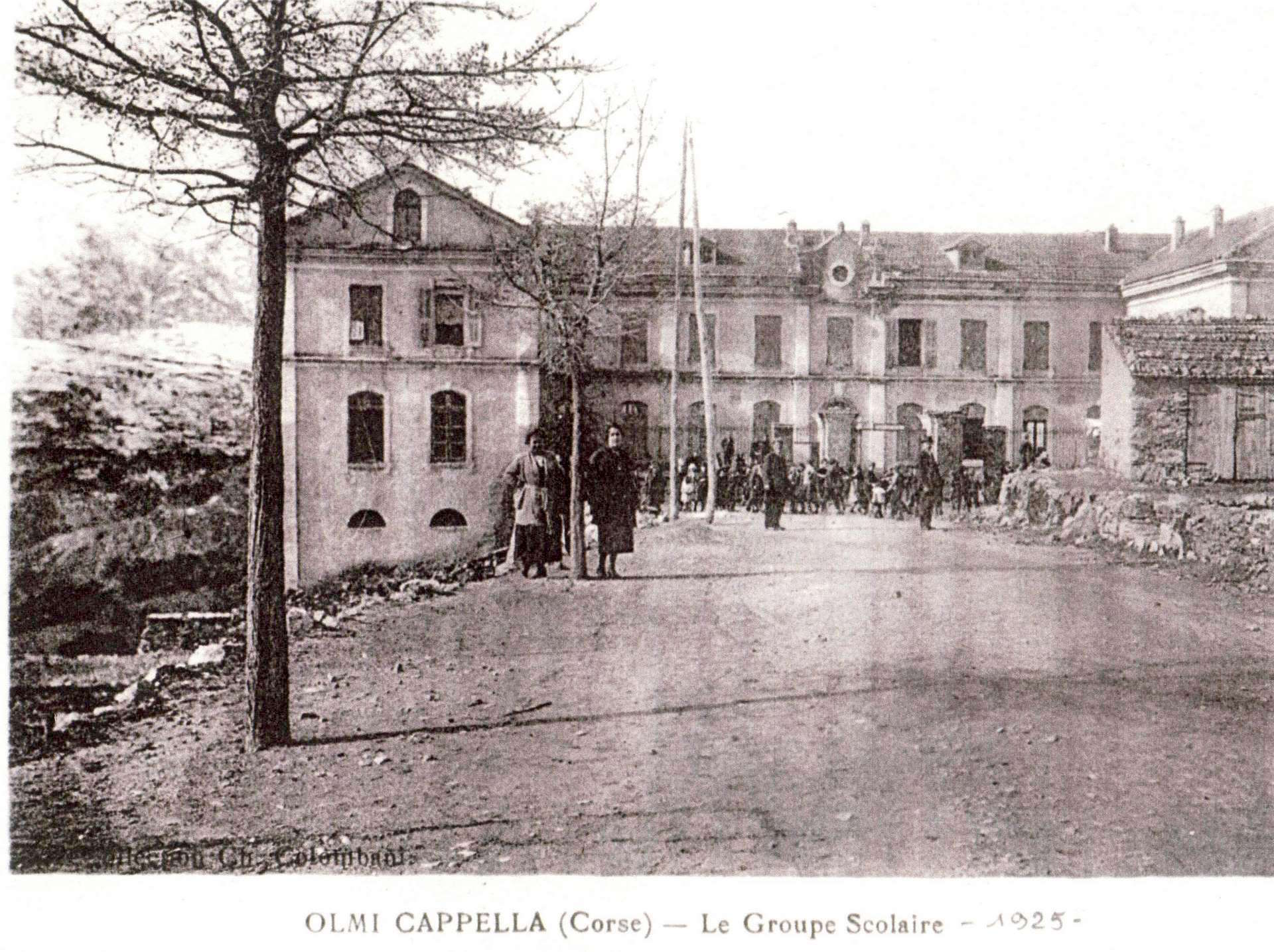This little painting hung on the wall of our house in Calvi. It looked like the campanile of one of the churches we visited yesterday, perhaps in Calenzana or maybe Montemaggiore.
The Genoese… besides tending their gardens, they built churches, so many over the centuries… that the region was called ‘holy Balagne’; today their bell towers charmingly punctuate the landscape like a series of mild exclamation marks.
Corsica: Dana Facaros & Michael Pauls
But when I took it down I found Église d’Avapessa handwritten on the back.
So today Avapessa was our first stop. But no matter how we looked at it, this was not the same campanile that appeared in our painting. The village was so small and the houses so closely knitted together that there was no space to stand back far enough from the tower to see it as the painter had.
Unless his viewpoint had since disappeared.
Inside the church was a little theatre of painted figures who all froze as soon as we entered.
The village was quiet.
This was the way we had come,
and this was the view back to Avapessa from further up the road,
and this was the way ahead through Muro to Speloncato.
Picturesque Speloncato clings to a Swiss cheese of a rock that gave the village its name, ‘cavey’. The most famous hole is the Pietra Tafonata, the ‘pierced rock’, 2km away but visible from just to the left of the hotel in Place de la Liberation. This is a 26ft/8m tunnel, though it looks like a pinhole from the square; twice a year at 6pm people gather to see Speloncato’s private laser show: the sun goes down, then about 10 seconds later reappears in the hole, filling the ‘place’ with a spotlight. As with the taffoni, no one is quite sure how much of the Pietra Tafonata is natural, or if any of it was excavated by human hands; archeologists found Neolithic bits and bobs on the floor in the tunnel. The Romanesque church of San Michele, with a portal dated 1509, was built over another cave that sheltered women and children in times of danger. Pius IX’s chief of police, Cardinal Savelli, was a native of Speloncato; ruling with an iron fist in an iron glove, he earned the whispered nickname il cane corso, ‘the Corsican dog’.
Corsica: Dana Facaros & Michael Pauls
From Speloncato we followed the steep winding corniche road, climbing ever higher into the clouds. We stopped to take in the view before it disappeared. Click on the image above to explore the fantastic wide panorama over the Regino Plain to the sea beyond. Speloncato is right of centre. The maquis was rich and fragrant and alive with birdsong and a distant echoing cuckoo.
Next time we stopped to look, the view was gone. There was whiteout at the edge of the road. A hang-glider might leap from here and sail for miles. It was unnerving to think of the huge invisible drop. Better to keep my eyes on the road, and when that disappeared, better to keep my eyes on the satnav.
We pulled off the road into the car park of A Merendella on the Col de Bataille, the gateway between the Balagne and the Giussani. At 1,101m or 3,612ft, we were 50ft higher than the summit of Snowdon.
The wildest and most remote part of the Balagne ‘fertile’, the Giussani runs along the valley of the Tartagine river in between Corsica’s northernmost giants, Monte Grosso (6,358ft/1,938m) and Monte Padro (7,851ft/2,393m). Two lofty passes are the only way into its four lovely villages, where the 170 people who have stayed behind live in a majestic, arcadian setting of chestnut and oak forests and towering peaks.
Corsica: Dana Facaros & Michael Pauls
And so then we descended the far side, into the lost valley of Giussani, Corsica’s own Shangri-la.
We hesitated on the way down at the Église Santa Maria Assunta, the sanctuary of Saint Pancrace,
an empty church with closed doors in the middle of nowhere, but with a great view of everywhere.
We continued our descent, down into the valley of the Tartagine. We were headed for the village of Olmi-Cappella where I’d heard there lived a giant.
Guide des Arbres Remarquables de France – Association A.R.B.R.E.S
It was hard to find the centre of the village, the houses were spread out all around and the church seemed out on a limb. We found ourselves outside the largest building, an ancient college known as the Bâtiment, which, according to the notices outside, was home to an international theatre school, a library, tourist information and post office. I went inside and looked around, up and down corridors but found no information and no-one to tell us how to find the great chêne vert d’Olmi-Cappella.
We walked up and down the road looking for clues. In the distance, over the fields, there were many old trees, then one in particular seemed bigger than the rest, but there was no direct way to get to it. We circled round, down behind the Bâtiment and a kindly dung beetle showed us the way.
Our arrival did not go unnoticed.
The road was raised up above the field to our right, which fell away down into the valley, and the enormous tree grew from the embankment, its many trunks and branches providing a shelter for the shade-loving cows below, most of whom seemed reluctant to welcome us to their pastoral idyll.
The tree was much more friendly and greeted us with an open hand, inviting us to climb into its palm and nestle within the arbour of its fingers. Caught one more time, and there was no better place to be.
Then I climbed up the bank and looked back down into the hand that had held me.
The holm oak of Olmi-Cappella is one of the remarkable trees of Corsica, it reaches exceptional proportions. It has been cited as one of the biggest oaks in Europe. Its trunk has a circumference of 8 metres (26 feet) and each of its 24 main branches is itself a true oak.
Some say this is the biggest holm oak in Europe.
Le Chêne Vert translates as the green oak, but better to say evergreen oak, otherwise known as Quercus ilex, holly oak or holm oak, an evergreen broadleaf oak native to the Mediterranean region. And this particular chêne vert is also known as the Sage Vert (sage as in old and wise) and U Saviu Verde, the green saviour. Local schoolchildren stage theatrical productions beneath its branches.
It carries a road on its back and holds a wooden bench in its arms, a place to sit awhile and be held in its green embrace, to be still and resist the temptation to go climbing up through its mesh of branches.
I got a free hug. A tree hug. I was a tree VIP. For a moment I was king of the tree, but it soon got the better of me. Its there now, dreaming under the sky, reaching out to the mountains, sheltering cattle.
We said goodbye to Le Chêne Vert and Olmi-Cappella and made our way up the Tartagine valley to Pioggiola and said hello to U Pasturellu where we got a nice welcome and a great lunch. We were told that if we continued up the road we would eventually come to the Forêt de la Tartagine where there are many paths and lots of interesting walks through the forest. It sounded like a good plan.
The slow winding road grew longer and longer and evermore curvaceous, with many emergency stops for jaw-dropping views. As the road grew narrower we were lucky not to meet any on-coming traffic.
The road ended at the Maison Forestière and a confusion of paths in all directions. We tried them all, and tied ourselves in knots. Which way, this way, anyway and back again, all around the Tartagine.
A corniche of caterpillars.
The pine processionary moth, precociously named after its larvae.
chêne vert
After a short walk in many directions at once we untied ourselves and headed back.
At the Col de Bataille the clouds were lifting.
The veiled oak we’d seen earlier was now silhouetted against the sun,
and we were momentarily caught in the web of its long shadow.
There was no longer a whiteout at the edge of the road.
We could see for miles.
The clouds were evaporating.
And there…
suddenly shining in the far distance, was the Golfe de la Revellata,
its distinctive headland sheltering the port of Calvi down below.
We could see all the way home.


















































































